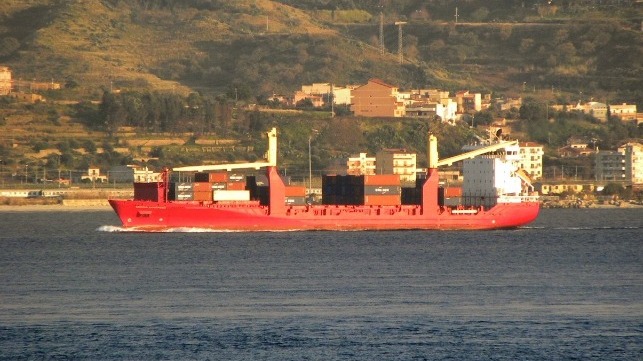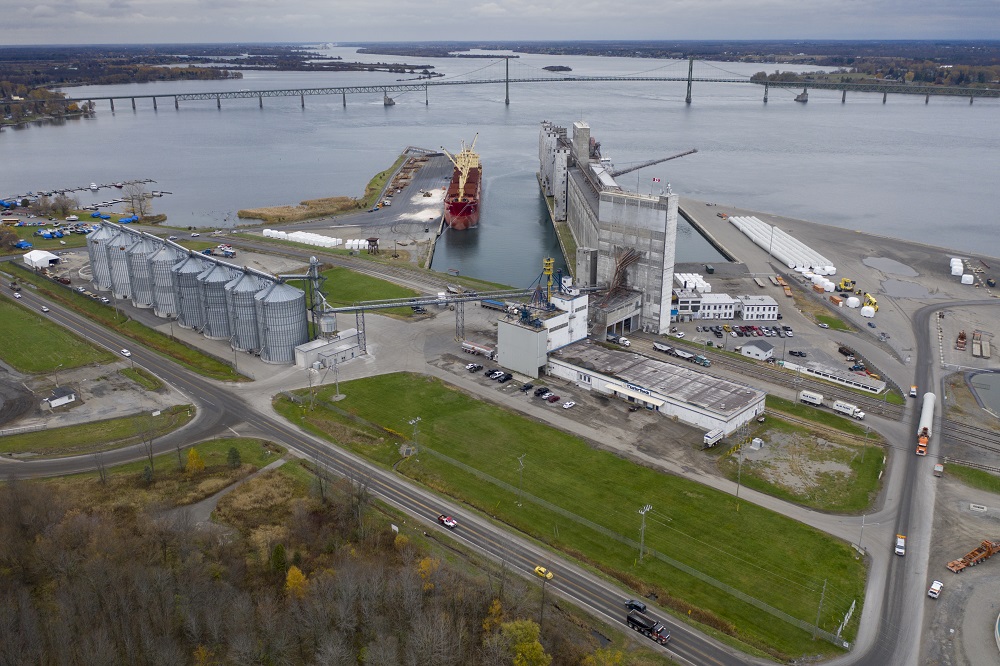Construction Company Starts New Container Line for Seaway Ports

A family-owned construction company based in Odessa, Ontario plans to introduce twice-weekly ship transportation service between Eastern Canada’s Port of Halifax and ports located along the Upper St. Lawrence River and Lower Great Lakes. The newly-founded Doornekamp Lines intends to carry containers, project freight and breakbulk cargo.
Introduction
The introduction of larger container ships on the trans-North Atlantic service between the Port of Newark and European/Western Asian ports provides opportunities for container transshipment and ship interlining at Eastern Canada’s Port of Halifax. Development of new container transfer technology enhances future business prospects for future container transshipment at Halifax that has the potential to evolve into a companion port for the Ports of Newark and of Boston. There is identical sailing distance between Europe and Port of Newark irrespective of whether or not a ship briefly stops at Halifax for container transshipment.
The new super-size container ships are too big to sail into the Ports of Boston and Portland where there is also insufficient market demand to warrant using the big ships. There is economic merit in sailing a single large ship across the North Atlantic while carrying containers destined for multiple ports that include Newark, New York City, Boston and Portland, with container transshipment occurring at Halifax. However, transshipment at Halifax opens the door to include containers for other destinations including orts located along the Upper St. Lawrence River (Seaway) and around Lakes Ontario and Erie.
Small Ship Precedent
While container ships in excess of 12,000 TEU sail across the North Atlantic, Halifax south terminal is being upgraded to provide service to larger container ships. Using container transfer technology increases the volume of container transshipment to multiple interlining ships. However, a comparatively diminutive container ship of less than 1,000 TEU capacity has feasibly sailed across the North Atlantic and Lower Great Lakes between the Ports of Antwerp and Cleveland. The high cost of container railway transportation between Newark and Cleveland offsets the savings from sailing a large ship to Newark, making the small ship cost-competitive.
That ship provides the basis to develop a business plan involving a comparable size of ship to sail a seasonal interline service between Halifax and inland waterway ports located upstream of the Port of Montreal. Doornekamp Lines has developed such a business plan.
Competitiveness
Doornekamp Lines has negotiated a partnership agreement with the French ocean carrier CMA CGM, which sails into Halifax and Newark. They plan to carry interlined containers and other freight between Halifax and ports located along the St. Lawrence Seaway and Lower Great Lakes. However, Canadian “cabotage” regulations will determine the competitiveness of the proposed interlined ship service against railway transportation. One interpretation of Canadian regulations could actually allow Doornekamp Lines to fly a European flag from Halifax while sailing to Canadian Seaway ports, thereby saving the higher expense of flying the Canadian flag.
Ships stopping at Halifax typically carry three to five times the number of containers than ships that sail to Montreal and incur much lower per container transportation costs sailing from European and Western Asian ports. The Doornekamp Lines interlined service has the potential to extend the overall competitive container transportation rates between Asian/European ports of origin and destination ports located along the Seaway and Lower Great Lakes. Their service would suit customers who are willing to delay container delivery in exchange for substantial savings in overall per container transportation rates.
Regulation
Transportation regulation could restrict the interlining ship sailing from Halifax to serve only the American ports of Ogdensburg, New York and Cleveland, Ohio. Canadian bound containers destined for retail related distribution warehouses located across Eastern Ontario would be offloaded at Ogdensburg and carried by truck to their final destinations, despite the Port of Johnstown, Ontario being located directly across the river from Ogdensburg. A tug barge would carry containers from Ogdensburg across the international border to any of the ports of Toronto, Oshawa or Hamilton, with final destinations for containers spread across the greater metropolitan Toronto region.

Port of Johnstown, Ontario (courtesy Port of Johnstown)
An interpretation of Canadian transportation regulation will determine whether an interline ship sailing from Halifax would serve only American inland waterway ports or whether the ship will also serve Canadian Seaway and Lower Great Lakes ports.
Ship vs railway cost
Prior to the reconstruction of the Panama Canal to transit larger container ships, an American transportation research group compared the cost of moving a full ship load of containers from the Port of Long Beach CA and the inland waterway Port of Memphis. Despite an older generation Panamax ship having to sail 3-times the distance via the Panama Canal compared to the more direct railway journey, the ship interlined with a tug-barge flotilla incurred savings in per container transportation costs over a fleet of railway trains traveling over a much shorter and more direct route.
The higher transportation cost per container aboard trans-continental trains prompted the reconstruction of the Panama Canal to transit larger container ships, which would sail between Asian ports and east coast American ports, providing lower per container transportation cost upon arrival at their eastern destinations. Larger ships will sail between some Asian ports and east coast American ports via a soon to be expanded twin-channel Suez Canal, with future potential to displace Panamax ships that sail to the same ports via the Panama Canal, extending time-in-transit duration in exchange for reduced per container transportation costs.
Asian containers to Seaway ports
Containers destined for Eastern Canada arrive at Pacific maritime ports followed by costly trans-continental railway transportation service. Customers located around the Lower Great Lakes and Seaway may reduce container transportation costs by scheduling container delivery during the Seaway shipping season. Maritime transportation will provide lower costs carrying their containers via the Suez Canal from Asian ports to Seaway and Lower Great Lakes ports.
A container ship of under 1,000 TEU feasibly sailing between the Ports of Antwerp and Cleveland (metro population two million) suggests potentially feasible interlined sailing to a metropolitan population of six million located in and around Toronto. Over-zealous regulation and not market forces would likely prevent Doornekamp Lines from extending their proposed interlined ship transportation service from Halifax to Toronto. The Toronto region offers a substantial market for lower priority containers shipped on extended delivery schedules at lower per container transportation rates. Several large distribution warehouses are located east of Toronto near Seaway ports.
It is a forgone conclusion that the railways and truck companies would negotiate to carry the winter minimum of container traffic throughout the year. The railways would continue to carry the higher-priority containers from Asian ports across Canada, leaving maritime to carry the lower priority containers and a portion of the seasonal peak in container traffic that occurs during the latter months of the year, prior to the annual seasonal closure of the Seaway. During transit, the ships fulfill the role of mobile floating warehouses for the distribution warehouses, which can schedule arrival of low and high priority containers.
Conclusions
The successful precedent of a diminutive container ship feasibly sailing between the Ports of Antwerp, Belgium and Cleveland provides a basis to develop an interlining ship transportation service to sail between the container transshipment Port of Halifax and the Lower Great Lakes. The ship will interline with ocean going super-size ships operated by the CMA CGM Group on the trans-North Atlantic service to the Port of Newark, from ports of origin located around Europe and extending into Asia. There is potential for a seasonal interlining service to be feasible, with regulation determining which inland ports it will serve.
The opinions expressed herein are the author's and not necessarily those of The Maritime Executive.
